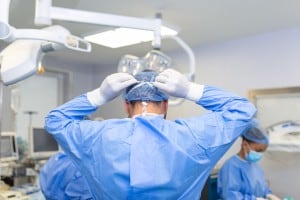Robotic surgery is an excellent option for many patients, including those who previously didn’t qualify for other types of procedures.
At Regional One Health, general surgeon Dr. Nabajit Choudhury provides robotic procedures for hernia repair, gallbladder removal, and more.
These procedures are minimally invasive, which means patients have fewer complications and an easier recovery.
If you need surgery, a minimally invasive robotic procedure can offer an excellent outcome with fewer complications, less risk, and a shorter, easier recovery.
Dr. Nabajit Choudhury, a general surgeon at Regional One Health, said many patients can have robotic surgery for hernia repair, gallbladder removal, stomach surgery and more.
Dr. Nabajit Choudhury, a general surgeon at Regional One Health, said many patients can have robotic surgery for hernia repair, gallbladder removal, stomach surgery and more.
“Robotic surgery has a lot of advantages,” he said. “It allows us to provide more options and to operate on patients who might not have been eligible for other types of surgery. Our patients also tend to experience less pain from their procedure and have a quicker recovery.”
At Regional One Health, Dr. Choudhury uses the state-of-the-art da Vinci Surgical System, which gives him advanced instruments he guides using a console. The instruments translate his hand movements and provide enhanced range of motion, precision, flexibility and control. A high-definition camera gives him a magnified, three-dimensional view of the surgical site.
The procedures are performed through tiny incisions of less than a centimeter.
Because the robot is so accurate, he can use it for complex procedures that previously required open surgery, which involves a large incision, longer hospital stay, and significant recovery time.

Dr. Nabajit Choudhury says robotic surgery can help many patients have successful outcomes: “It has a lot of advantages,” he said. “Patients tend to experience less pain and a quicker recovery.”
Dr. Choudhury said that makes robotic surgery a game-changer for his patients. “Many patients come to us with hernias that were too large to operate on laparoscopically. With robotic surgery, we can take care of those,” he said. “There’s very little chance we’ll have to do open surgery.”
In some cases, he can even combine procedures. He can repair multiple hernias with one surgery, or combine gallbladder removal and hernia repair.
“We can take care of the hernia first and then remove the gallbladder so there’s no chance of contamination,” he said. “It can lengthen the time spent in surgery, but the patient is only under anesthesia once, and that’s a big advantage.”
Dr. Choudhury can also use robotic technology to operate on patients with a BMI over 35 who previously might not have qualified for surgery.
“These patients used to be denied surgery because there was a higher chance of complications with wound healing, blood clots and infection,” he said. “Patients would be told they had to lose weight first, which was a big barrier. Many ended up forgoing surgery. With robotic surgery, we have another option for treating these patients.”
Robotic surgeries also tend to be easier on patients.
Procedures are usually shorter, and patients experience less scarring and fewer complications such as blood loss or wound infection. Patients report less pain during recovery: “We can use minimal narcotics with the robot. A lot of times patients can manage their pain with Tylenol or Motrin,” Dr. Choudhury said.
Many patients are able to leave the hospital the same day, resume light activity the next day, resume driving within a few days, and return to work in about a week or two.

Robotic procedures are available for hernia repair, gallbladder removal and more. In some cases, surgeons can combine procedures, which means patients are only under anesthesia once.
Best of all, outcomes from robotic surgery are excellent. “Once we fix the problem and the patient recovers from surgery, they feel much better,” Dr. Choudhury said. “The problem has been removed, so they feel back to normal.”
Along with robotic surgery, Dr. Choudhury offers laparoscopic and open surgery for a variety of conditions.
Non-emergency procedures include hernia repair and elective gallbladder removal for patients who suffer from frequent bouts of gallstones. Dr. Choudhury also does emergency gallbladder removal and emergency surgery for acute conditions like appendicitis and intestinal blockages.
Dr. Choudhury aims to identify the safest, most effective procedure for each patient and make sure they understand what will happen during and after surgery, risks, and likely outcomes.
“Patients give us their trust to take care of them and to fix them. Being able to do that is a great opportunity for anyone in the medical field,” he said.